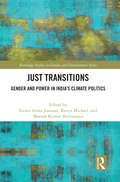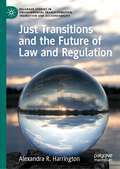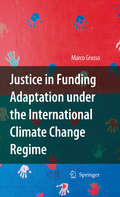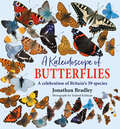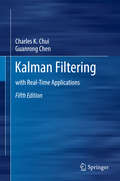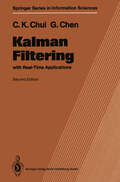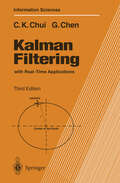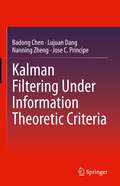- Table View
- List View
Just Transitions: Gender and Power in India’s Climate Politics (Routledge Studies in Gender and Environments)
This book turns critical feminist scrutiny on national climate policies in India and examines what transition might really mean for marginalized groups in the country. A vision of “just transitions” is increasingly being used by activists and groups to ensure that pathways towards sustainable futures are equitable and inclusive. Exploring this concept, this volume provides a feminist study of what it would take to ensure just transitions in India where gender, in relation to its interesting dimensions of power, is at the centre of analysis. With case studies on climate mitigation and adaptation from different parts of India, the book brings together academics, practitioners and policymakers who provide commentary on sectors including agriculture, forestry and renewables. Overall, the book has relevance far beyond India’s borders, as India’s attempt to deal with its diverse population makes it a key litmus test for countries seeking to transition against a backdrop of inequality both in the Global North and South. This volume will be of great interest to students and scholars of climate policy, gender studies, sustainable development and development studies more broadly.
Just Transitions and the Future of Law and Regulation (Palgrave Studies in Environmental Transformation, Transition and Accountability)
by Alexandra R. HarringtonThis book provides a comprehensive assessment of how national and international efforts to achieve carbon neutrality have been embraced as necessary to meet the requirements of the Paris Agreement as well as the needs of the planet. The authors explore the increasing tensions between aspirations and entrenched practices as methods to implement carbon neutrality are devised, particularly at the national and sub-national levels. This is perhaps best typified by efforts to shift from “dirty” energy production, such as coal, to greener alternatives, which are often supported in laws and rules but opposed by society. To bridge this void, the concept of just transitions has increasingly come to the forefront of international and national focus yet is often poorly understood. This book examines the ways in which just transitions have been proposed as a legal and regulatory bridge to address issues that result in societal resistance to implementation. It uses past and existing practice studies of just transitions before providing an analysis of how just transitions can be used to not only to assist in the shift to carbon neutrality but also in new shifts such as those caused by the Covid-19 pandemic impacts on economy, environment and society, and to address future global challenges.
Justice and Cities: Metro Morals
by Mark DavidsonThis book explores different theories of justice and explains how these connect to broader geographical questions and inform our understanding of urban problems. Since philosophers like Socrates debated in the ancient agora, cities have prompted arguments about the best ways to live together. Cities have also produced some of the most vexing moral problems, including the critical question of what obligations we have to people we neither know nor affiliate with. The first part of this book outlines the most well-developed answers to these questions: the justice theories of Utilitarianism, Libertarianism, Liberalism, Marxism, Communitarianism, Conservativism, and recent "post" critiques. Within each theory, we find a set of geographical propensities that shape the ways purveyors of the theories see the city and its moral problems. The central thesis of the book is therefore that competing moral theories have distinct geographical concerns and perspectives, and that these propensities often condition how the city and its injustices are understood. The second part of the book features three studies of contemporary urban problems – gentrification, segregation, and (un)affordability – to demonstrate how predominant justice theories generate distinctive moral and geographical interpretations. This book therefore serves as an urbanist’s guide to justice theory, written for undergraduates and postgraduates studying human geography, urban and municipal planning, urban theory and urban politics, sociology, and politics and government.
Justice and Cities: Metro Morals
by Mark DavidsonThis book explores different theories of justice and explains how these connect to broader geographical questions and inform our understanding of urban problems. Since philosophers like Socrates debated in the ancient agora, cities have prompted arguments about the best ways to live together. Cities have also produced some of the most vexing moral problems, including the critical question of what obligations we have to people we neither know nor affiliate with. The first part of this book outlines the most well-developed answers to these questions: the justice theories of Utilitarianism, Libertarianism, Liberalism, Marxism, Communitarianism, Conservativism, and recent "post" critiques. Within each theory, we find a set of geographical propensities that shape the ways purveyors of the theories see the city and its moral problems. The central thesis of the book is therefore that competing moral theories have distinct geographical concerns and perspectives, and that these propensities often condition how the city and its injustices are understood. The second part of the book features three studies of contemporary urban problems – gentrification, segregation, and (un)affordability – to demonstrate how predominant justice theories generate distinctive moral and geographical interpretations. This book therefore serves as an urbanist’s guide to justice theory, written for undergraduates and postgraduates studying human geography, urban and municipal planning, urban theory and urban politics, sociology, and politics and government.
Justice, Equity and Emergency Management (Community, Environment and Disaster Risk Management #25)
by Alessandra Jerolleman William L. WaughThe Community, Environment and Disaster Risk Management series deals with a wide range of issues relating to global environmental hazards, natural and man-made disasters, and approaches to disaster risk reduction. As people and communities are the first and the most important responders to disasters and environment-related problems, this series aims to analyse critical field-based mechanisms which link community, policy, and governance systems. Justice, Equity and Emergency Management takes the principles proposed in Disaster Recovery Through the Lens of Justice and applies a justice and equity lens across all phases of emergency management, focusing on key topics such as hazard mitigation, emerging technologies, long-term recovery, and others. The authors in this volume interrogate the applicability of the principles to technological innovation, indigenous peoples, persons with access and functional needs, agricultural disasters, and several other contexts. It is our hope that this effort will lead us closer to truly operationalizing and applying these principles in a way that leads to systemic change and better outcomes.
Justice, Equity and Emergency Management (Community, Environment and Disaster Risk Management #25)
by Alessandra Jerolleman And William L. Waugh JrThe Community, Environment and Disaster Risk Management series deals with a wide range of issues relating to global environmental hazards, natural and man-made disasters, and approaches to disaster risk reduction. As people and communities are the first and the most important responders to disasters and environment-related problems, this series aims to analyse critical field-based mechanisms which link community, policy, and governance systems. Justice, Equity and Emergency Management takes the principles proposed in Disaster Recovery Through the Lens of Justice and applies a justice and equity lens across all phases of emergency management, focusing on key topics such as hazard mitigation, emerging technologies, long-term recovery, and others. The authors in this volume interrogate the applicability of the principles to technological innovation, indigenous peoples, persons with access and functional needs, agricultural disasters, and several other contexts. It is our hope that this effort will lead us closer to truly operationalizing and applying these principles in a way that leads to systemic change and better outcomes.
Justice in Climate Action Planning (Strategies for Sustainability)
by Brian Petersen Hélène B. DucrosThis edited volume examines how climate action plans engage justice at the scale of the city. Recent events in the United States make the context particularly ripe for a discussion of justice in urban climate politics. On the one hand, the emergence of the Black Lives Matter movement, George Floyd’s death, and the prominence of racial discrimination in the public realm have mainstreamed the notion of justice. On the other hand, the dire consequences of increased frequency and severity of climate events on vulnerable segments of urban populations are undeniable. While some cities have been proactive about integrating justice in their climate action planning, in most places an explicit and systematic link between both spheres has been lacking. This book explores this interface as it seeks to understand how cities can respond to climate change in a just way and for just outcomes. While resilience strategies based on “development” may engage historic inequities, they may at the same time result in marginalizing certain populations through various processes, from mismatched solutions to outright exclusion and climate gentrification. By identifying how certain populations are included in or excluded from climate action planning practices, the chapters in this volume draw on case studies to outline the differential outcomes of climate action in American cities, also proposing a template for comparative work beyond the US. The authors tackle the debate about how justice is or is not integrated in climate action plans and assess practical implications, while also making theoretical and methodological contributions. As it fills a gap in the literature at the intersection of justice and climate action, the book produces new insights for a wide-ranging audience: students, practitioners, policy-makers, planners, the non-profit sector, and scholars in geography, urban planning, urban studies, environmental studies, ecology, political science, or anthropology. Along five axes of investigation―theory, resilience, equity, community, and comparison as method―the contributors offer various pathways into the intersection between urban climate action and different understandings of justice. Collectively, they invite a reflection that can lead to practical initiatives in climate mitigation, while also advancing the theorization of social justice to account for the urban as a node where (in)justice plays out and can be addressed with significant results.
Justice in Climate Policy: Distributing Climate Costs Fairly (Research for Policy)
by Mark Bovens Victor Toom Annick de Vries Gijsbert Werner Elsenoor Wijlhuizen Suzanne HulscherThis open access book is looking into ways to achieve just climate policy within a country. The authors of this monograph share a unique, timely and original vision: continuous support for climate policy is more likely to emerge when citizens find that the distribution of the bill for climate costs is fair. But what is a fair distribution of climate costs? This is an important question because financial costs of mitigation (reducing greenhouse gases), adaptation (adapting to climate change) and damage (compensating or compensating after weather extremes) increase significantly in the coming decades. Drawing on philosophy and ethics, the authors propose ten principles for achieving just distributions of domestic climate costs. Examples of such principles are individual responsibility, the polluter pays, greatest utility and capacity to pay. Yet what a fair distribution is, depends on, for example, political preferences and the policy issue at hand. Empirical research on designing climate policies, however, shows that distributive principles are not part of the political, policy, and public discussions. The authors therefore argue that explicit attention to principles of just distribution at the start of a policy process contributes to support for climate policy. This book provides tools to professionals and students to achieve justice in climate policy.
Justice in Funding Adaptation under the International Climate Change Regime
by Marco GrassoCovering the ethical dimensions of international-level adaptation funding, a subject of growing interest in the climate change debate, this book provides a theoretical analysis of the ethical foundations of the UNFCCC regime on adaptation funding, one that culminates in the definition of a framework of justice. The text features an interpretative analysis of the ethical contents of the UNFCCC funding architecture by applying the framework of justice proposed to different areas of empirical investigation. The book offers scholars working on climate change, international relations, and environmental politics an analysis characterized by both theoretical soundness and empirical richness. The comprehensiveness of the book’s approach should make it possible to plan and implement international adaptation funding more effectively, and eventually to define more just funding policies and practices.
Justice, Society and Nature: An Exploration of Political Ecology
by Brendan Gleeson Nicholas LowJustice, Society and Nature examines the moral response which the world must make to the ecological crisis if there is to be real change in the global society and economy to favour ecological integrity. From its base in the idea of the self, through principles of political justice, to the justice of global institutions, the authors trace the layered structure of the philosophy of justice as it applies to environmental and ecological issues. Philosophical ideas are treated in a straightforward and easily understandable way with reference to practical examples. Moving straight to the heart of pressing international and national concerns, the authors explore the issues of environment and development, fair treatment of humans and non-humans, and the justice of the social and economic systems which affect the health and safety of the peoples of the world. Current grass-roots concerns such as the environmental justice movement in the USA, and the ethics of the international regulation of development are examined in depth. The authors take debates beyond mere complaint about the injustice of the world economy, and suggest what should now be done to do justice to nature.
Justice, Society and Nature: An Exploration of Political Ecology
by Brendan Gleeson Nicholas LowJustice, Society and Nature examines the moral response which the world must make to the ecological crisis if there is to be real change in the global society and economy to favour ecological integrity. From its base in the idea of the self, through principles of political justice, to the justice of global institutions, the authors trace the layered structure of the philosophy of justice as it applies to environmental and ecological issues. Philosophical ideas are treated in a straightforward and easily understandable way with reference to practical examples. Moving straight to the heart of pressing international and national concerns, the authors explore the issues of environment and development, fair treatment of humans and non-humans, and the justice of the social and economic systems which affect the health and safety of the peoples of the world. Current grass-roots concerns such as the environmental justice movement in the USA, and the ethics of the international regulation of development are examined in depth. The authors take debates beyond mere complaint about the injustice of the world economy, and suggest what should now be done to do justice to nature.
Justice, Sustainability, and Security: Global Ethics for the 21st Century
by Eric A. HeinzeJustice, Sustainability, and Security not only enhances our knowledge of these issues, but it teases out our moral dimensions and offer prescriptions for how governments and global actors might craft their policies to better consider their effects on the global human condition.
The Justices and Injustices of Ecosystem Services (Routledge Studies in Ecosystem Services)
by Thomas SikorHumankind benefits from a multitude of resources and processes that are supplied by ecosystems, and collectively these benefits are known as ecosystem services. Interest in this topic has grown exponentially over the last decade, as biologists and economists have tried to quantify these benefits to justify management interventions. Yet, as this book demonstrates, the implications for justice and injustice have rarely been explored and works on environmental justice are only now addressing the importance of ecosystem services. The authors establish important new middle ground in arguments between conservationists and critics of market-based interventions such as Payment for Ecosystem Services. Neither can environmental management be separated from justice concerns, as some conservationists like to believe, nor is it in fundamental opposition to justice, as critics like to put it. The book develops this novel interpretation of justice in environmental management through analyses of prominent governance interventions and the conceptual underpinnings of the ecosystem services framework. Key examples described are revenue-sharing around protected areas and REDD+ for forest ecosystems. The analyses demonstrate that interventions create opportunities for enhancing social justice, yet also reveal critical design features that cause ostensibly technical interventions to generate injustices.
The Justices and Injustices of Ecosystem Services (Routledge Studies in Ecosystem Services)
by Thomas SikorHumankind benefits from a multitude of resources and processes that are supplied by ecosystems, and collectively these benefits are known as ecosystem services. Interest in this topic has grown exponentially over the last decade, as biologists and economists have tried to quantify these benefits to justify management interventions. Yet, as this book demonstrates, the implications for justice and injustice have rarely been explored and works on environmental justice are only now addressing the importance of ecosystem services. The authors establish important new middle ground in arguments between conservationists and critics of market-based interventions such as Payment for Ecosystem Services. Neither can environmental management be separated from justice concerns, as some conservationists like to believe, nor is it in fundamental opposition to justice, as critics like to put it. The book develops this novel interpretation of justice in environmental management through analyses of prominent governance interventions and the conceptual underpinnings of the ecosystem services framework. Key examples described are revenue-sharing around protected areas and REDD+ for forest ecosystems. The analyses demonstrate that interventions create opportunities for enhancing social justice, yet also reveal critical design features that cause ostensibly technical interventions to generate injustices.
Justitiabler Klimaschutz in Deutschland: Welchen Beitrag können Gerichte zum Klimaschutz leisten? (Schriftenreihe des Instituts für Klimaschutz, Energie und Mobilität)
by Michael KalisIn dieser Schrift wird aufbauend auf den Erkenntnissen der Climate Change Litigation und dem Phänomen der sog. Klimaklagen die Justitiabilität von Klimaschutz in Deutschland untersucht. Dabei wird der Untersuchungsgegenstand auf Klimaschutzklagen, d.h. auf vertikale Klagen von Privaten gegen den Staat mit dem Begehren auf verbesserte oder sonst adäquate Klimaschutzmaßnahmen, beschränkt. Nach einer Auseinandersetzung mit dem meist diffusen Begriff der Justitiabilität wird eine eigenständige Definition mit anschließendem Prüfungskanon entwickelt, der danach fragt, ob und inwieweit Klimaschutz vor deutschen Gerichten einklagbar ist; aber auch fragt, ob und inwieweit einschlägige Streitigkeiten zur gerichtlichen Klärung geeignet sind. Im Rahmen der Prüfung von Einklagbarkeit und Eignung werden die wesentlichen Herausforderungen der Klimaklagen identifiziert und – unter Berücksichtigung einschlägigen internationalen und europäischen Rechts – nach prozessualen und materiellen Verfassungsrecht geprüft. Unter Begründung eines subjektiven Rechts auf Klimaschutz im Sinne eines Schutzes der Freiheitsvoraussetzungen sowie unter Anwendung einer Abwägungsfehlerlehre als gerichtlicher Kontrollmaßstab wird die Justitiabilität von Klimaschutz in Deutschland bejaht. Dabei erfolgt – im deutschsprachigen Raum erstmals – eine monografische Auseinandersetzung mit dem sog. Klima-Beschluss des Bundesverfassungsgerichts.
Justus Ludewig von Uslar, and the First Book on Allelopathy
by R.J. WillisAllelopathy is a fascinating and perplexing topic that concerns the chemical interactions of plants. It has profound implications in agriculture and forestry where species are grown artificially in mixture, with no evolutionary history of co-existence. The topic of allelopathy is widely credited as commencing in 1937, when the term ‘allelopathy’ was coined by Molisch. However, the concept of allelopathy has been recorded since Greek and Roman times, became extremely controversial in the first half of the 19th century, and remains so today. This book concerns a virtually unknown treatise by Justus Ludewig von Uslar, published in 1844, which emerges as the first book entirely devoted to the concept of allelopathy. The book provides the historical background to allelopathic knowledge, from antiquity to c. 1840. It also provides for the first time a biography of Justus Ludewig von Uslar, who is best known as the first Consul-General for Hannover in Mexico, and Director of the Mexican Company, a British venture mining company. In many ways von Uslar epitomises the tradition of the gentleman scientist of the 19th century. The book then offers a full translation into English of von Uslar's rare treatise, which foreshadows many ideas current in allelopathic research.
Jute Geotextiles and their Applications in Civil Engineering (Developments in Geotechnical Engineering)
by Tapobrata SanyalThis book presents a first-of-its-kind exposition on the emerging technology of jute fiber geotextiles. The book covers the characteristics of jute fiber and jute yarns, types and functions of jute geotextiles, and the mechanism of control of surficial soil with jute geotextiles. The content also includes applications such as the mechanisms of functioning of jute geotextiles in strengthening road sub-grade and controlling river bank erosion, stabilization of earthen embankments, management of settlement of railway tracks, and consolidation of soft soil by use of pre-fabricated vertical jute drains (PVJD). Geotextile standards, properties and test methods, variants of jute geotextiles, economical and environmental advantages in different applications are covered along with a few case studies. A chapter on soil basics is included to enable clearer understanding of soil mechanisms. The book can be used as a reference work or as primary or supporting text for graduate and professional coursework. It will also prove useful to researchers and practicing engineers looking for a comprehensive treatise on jute geotextiles.
The Kadison-Singer Property (SpringerBriefs in Mathematical Physics #14)
by Marco StevensThis book gives a complete classification of all algebras with the Kadison-Singer property, when restricting to separable Hilbert spaces. The Kadison-Singer property deals with the following question: given a Hilbert space H and an abelian unital C*-subalgebra A of B(H), does every pure state on A extend uniquely to a pure state on B(H)? This question has deep connections to fundamental aspects of quantum physics, as is explained in the foreword by Klaas Landsman. The book starts with an accessible introduction to the concept of states and continues with a detailed proof of the classification of maximal Abelian von Neumann algebras, a very explicit construction of the Stone-Cech compactification and an account of the recent proof of the Kadison-Singer problem. At the end accessible appendices provide the necessary background material.This elementary account of the Kadison-Singer conjecture is very well-suited for graduate students interested in operator algebras and states, researchers who are non-specialists of the field, and/or interested in fundamental quantum physics.
The Kaguya Lunar Atlas: The Moon in High Resolution
by Motomaro Shirao Charles A. WoodIn late 2007, the Japanese Space Exploration Agency (JAXA) placed the Kaguya/ Selene spacecraft in orbit around the Moon to probe the Moon’s surface and interior. But unlike previous lunar orbiters, Kaguya carries a high definition television camera (HDTV) sent beyond Earth orbit. Sponsored by the Japanese NHK TV network, the HDTV has amazed both scientists and the public with its magnificent views of the lunar surface. What makes these images so much more engaging than standard vertical view lunar photography is that they are taken looking obliquely along the flight path. Thus, they show the Moon as it would be seen by an astronaut looking through a porthole window while orbiting only 100 km above the lunar surface. This is the view we all would wish to have but are never likely to, except vicariously through the awe-inspiring Kaguya HDTV images. Each page features a HDTV image with a map of the entire Moon on the upper left showing where the image is located. On the upper right is a 100-150 word description. Seeing the Moon is not intended solely for lunar scientists who are striving to work out the mysteries of the Moon’s origin and evolution. Everyone can appreciate the natural beauty and be entranced by the view of the nearby world where humans may one day live.
A Kaleidoscope of Butterflies: Britain's 59 resident species
by Jonathan BradleyThere are 59 species of British butterfly and each one deserves a couple of stunning photographs, some interesting facts about its life cycle and a poem dedicated to it. Lifelong butterfly lover and poet Jonathan Bradley and his photographer friend Yealand Kalfayan have done just that in this colourful and inspiring book. Bradley has also included a mini biography of several famous lepidopterists who have left their mark in this radiant world. This lovely, bright hardback is a feast for the eyes.
Kalman Filtering: with Real-Time Applications (Springer Series In Information Sciences Ser. #17)
by Charles K. Chui Guanrong ChenThis new edition presents a thorough discussion of the mathematical theory and computational schemes of Kalman filtering. The filtering algorithms are derived via different approaches, including a direct method consisting of a series of elementary steps, and an indirect method based on innovation projection. Other topics include Kalman filtering for systems with correlated noise or colored noise, limiting Kalman filtering for time-invariant systems, extended Kalman filtering for nonlinear systems, interval Kalman filtering for uncertain systems, and wavelet Kalman filtering for multiresolution analysis of random signals. Most filtering algorithms are illustrated by using simplified radar tracking examples. The style of the book is informal, and the mathematics is elementary but rigorous. The text is self-contained, suitable for self-study, and accessible to all readers with a minimum knowledge of linear algebra, probability theory, and system engineering. Over 100 exercises and problems with solutions help deepen the knowledge. This new edition has a new chapter on filtering communication networks and data processing, together with new exercises and new real-time applications.
Kalman Filtering: with Real-Time Applications
by Charles K. Chui Guanrong Chen"Kalman Filtering with Real-Time Applications" presents a thorough discussion of the mathematical theory and computational schemes of Kalman filtering. The filtering algorithms are derived via different approaches, including a direct method consisting of a series of elementary steps, and an indirect method based on innovation projection. Other topics include Kalman filtering for systems with correlated noise or colored noise, limiting Kalman filtering for time-invariant systems, extended Kalman filtering for nonlinear systems, interval Kalman filtering for uncertain systems, and wavelet Kalman filtering for multiresolution analysis of random signals. The last two topics are new additions to this third edition. Most filtering algorithms are illustrated by using simplified radar tracking examples. The style of the book is informal, and the mathematics is elementary but rigorous. The text is self-contained, suitable for self-study, and accessible to all readers with a minimum knowledge.
Kalman Filtering: with Real-Time Applications (Springer Series in Information Sciences #17)
by Charles K. Chui Guanrong ChenIn addition to making a number of minor corrections and updat ing the references, we have expanded the section on "real-time system identification" in Chapter 10 of the first edition into two sections and combined it with Chapter 8. In its place, a very brief introduction to wavelet analysis is included in Chapter 10. Although the pyramid algorithms for wavelet decompositions and reconstructions are quite different from the Kalman filtering al gorithms, they can also be applied to time-domain filtering, and it is hoped that splines and wavelets can be incorporated with Kalman filtering in the near future. College Station and Houston Charles K. Chui September 1990 Guanrong Chen Preface to the First Edition Kalman filtering is an optimal state estimation process applied to a dynamic system that involves random perturbations. More precisely, the Kalman filter gives a linear, unbiased, and min imum error variance recursive algorithm to optimally estimate the unknown state of a dynamic system from noisy data taken at discrete real-time. It has been widely used in many areas of industrial and government applications such as video and laser tracking systems, satellite navigation, ballistic missile trajectory estimation, radar, and fire control. With the recent development of high-speed computers, the Kalman filter has become more use ful even for very complicated real-time applications.
Kalman Filtering: with Real-Time Applications (Springer Series in Information Sciences #17)
by Charles K. Chui Guanrong ChenKalman Filtering with Real-Time Applications presents a thorough discussion of the mathematical theory and computational schemes of Kalman filtering. The filtering algorithms are derived via different approaches, including a direct method consisting of a series of elementary steps, and an indirect method based on innovation projection. Other topics include Kalman filtering for systems with correlated noise or colored noise, limiting Kalman filtering for time-invariant systems, extended Kalman filtering for nonlinear systems, interval Kalman filtering for uncertain systems, and wavelet Kalman filtering for multiresolution analysis of random signals. The last two topics are new additions to this third edition. Most filtering algorithms are illustrated by using simplified radar tracking examples. The style of the book is informal, and the mathematics is elementary but rigorous. The text is self-contained, suitable for self-study, and accessible to all readers with a minimum knowled
Kalman Filtering Under Information Theoretic Criteria
by Badong Chen Lujuan Dang Nanning Zheng Jose C. PrincipeThis book provides several efficient Kalman filters (linear or nonlinear) under information theoretic criteria. They achieve excellent performance in complicated non-Gaussian noises with low computation complexity and have great practical application potential. The book combines all these perspectives and results in a single resource for students and practitioners in relevant application fields. Each chapter starts with a brief review of fundamentals, presents the material focused on the most important properties and evaluates comparatively the models discussing free parameters and their effect on the results. Proofs are provided at the end of each chapter. The book is geared to senior undergraduates with a basic understanding of linear algebra, signal processing and statistics, as well as graduate students or practitioners with experience in Kalman filtering.
